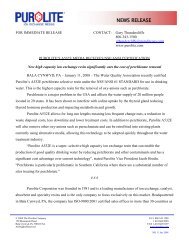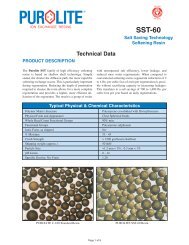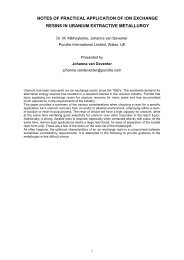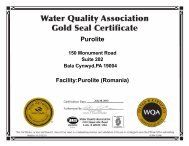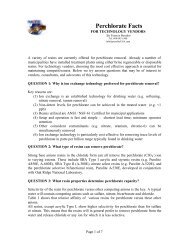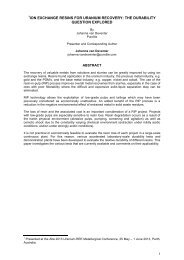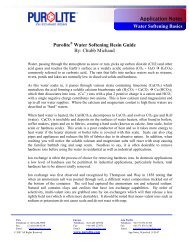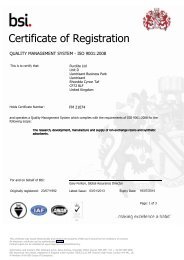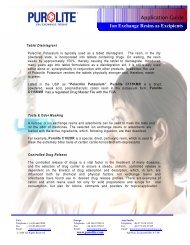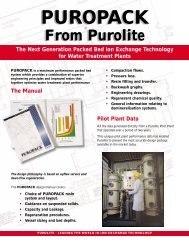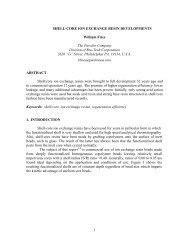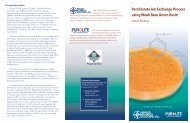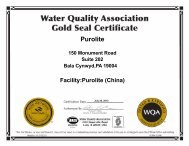Cane Sugar Refining - Purolite
Cane Sugar Refining - Purolite
Cane Sugar Refining - Purolite
You also want an ePaper? Increase the reach of your titles
YUMPU automatically turns print PDFs into web optimized ePapers that Google loves.
<strong>Cane</strong> <strong>Sugar</strong> <strong>Refining</strong> with Ion Exchange Resins<br />
<strong>Cane</strong> <strong>Sugar</strong> Refinery<br />
<strong>Sugar</strong> Receiving<br />
Some refineries are attached to cane mills while others are stand alone facilities. In a<br />
stand alone sugar refinery, raw sugar will arrive in bulk by barge, rail or trucks for<br />
unloading into the raw sugar warehouse. The raw sugar will undergo metal and<br />
debris removal and large lumps will be crushed prior to transfer to the mingler to<br />
begin remelting and refining.<br />
Affination<br />
The raw sugar is mingled with hot affination syrup which melts just the outermost<br />
layer of the raw sugar crystal. This outer layer contains the largest concentration of<br />
color. The resulting syrup from melting of the outer layer, is separated from the sugar<br />
crystals in a centrifuge. The bulk of the colorants are removed during the affination step<br />
(about 50% of raw sugar color) and then during the clarification step (about 40% of<br />
melt liquor color).<br />
Melter<br />
The affinated sugar is dissolved with hot condensate to a liquid concentration of<br />
approximately 72º Brix at 75ºC prior to defecation.<br />
Defecation/Clarification<br />
Approximately 40% of the remaining colorants are removed in the clarification step.<br />
There are two alternative types of defecation processes in use in cane refineries,<br />
carbonatation and phosphatation:<br />
Carbonatation, also called carbonation, involves adding lime (CaO) to the melt liquor and<br />
then passing this juice through a carbonation vessel where carbon dioxide (CO 2 ) is bubbled<br />
up through the juice. The reaction of the carbon dioxide with the lime produces a calcium<br />
carbonate precipitate. Color bodies are entrapped in the precipitate and are removed during<br />
filtration of the solids. Another action occurring in the limed melt liquor is destruction of<br />
invert sugars at the high pH produced by the lime. Polymers are added to the juice to assist<br />
in the formation of a precipitate floc which is more easily settled and filtered.<br />
Phosphatation involves addition of lime (CaO) and phosphoric acid (H 3 PO 4 or P 2 O 5 )<br />
to the melt liquor which results in formation of a calcium phosphate precipitate. Color<br />
bodies adsorb onto the calcium phosphate precipitate and are removed during the<br />
subsequent clarification and filtration. Polymers are added to aid in the formation of a<br />
precipitate floc which is more easily filtered.<br />
Filtration<br />
The clarified juice from carbonatation or phosphatation contains suspended solids which<br />
would plug the interstitial spaces and blind the pores of decolorization resin, bone char<br />
or carbon. Precoat vacuum filters, precoat pressure filters, deep bed multimedia filters or<br />
some combination of these are used to produce a filtered syrup which will flow through<br />
the decolorization columns without causing a pressure buildup.<br />
4



